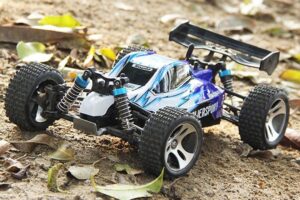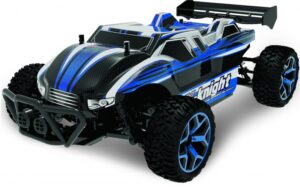4×4 rc carc
Description
Radio-controlled 4×4 cars are miniature remote-controlled vehicles that are designed to mimic the appearance and functionality of full-sized 4×4 off-road vehicles. These cars are popular among hobbyists and enthusiasts who enjoy the thrill of driving and racing miniature vehicles.
The “4×4” designation refers to the four-wheel-drive system used in these cars, which provides increased traction and stability on uneven or rough terrain. Most radio-controlled 4×4 cars have a range of around 100 to 200 feet and can be controlled using a handheld radio transmitter that sends signals to a receiver in the car.
These cars typically have a variety of features and capabilities, including suspension systems that can absorb shocks and bumps, high-grip tires that can handle a variety of surfaces, and powerful electric or gas motors that can propel the car at high speeds.
There are a variety of different types of radio-controlled 4×4 cars available, ranging from simple toy-grade models that are easy to operate and relatively affordable, to more advanced hobby-grade models that offer greater speed, power, and customization options.
Some hobbyists even choose to modify and customize their radio-controlled 4×4 cars, adding features like custom paint jobs, high-performance motors and batteries, and specialized suspension systems to create unique and personalized vehicles that can handle even the toughest terrain.
Types
There are several types of radio-controlled 4×4 vehicles, each with its own characteristics and capabilities. Here are a few examples:
- Monster trucks: These are large, powerful trucks with oversized tires and suspension systems that can handle jumps and rough terrain.
- Rock crawlers: These are slow-moving, highly specialized vehicles with low gearing and extreme suspension systems that allow them to climb over rocks and obstacles.
- Buggies: These are lightweight, high-speed vehicles with long suspension travel and aerodynamic bodies that make them ideal for racing on dirt tracks.
- Truggies: These are a combination of buggies and trucks, with the speed and agility of a buggy and the durability and off-road capabilities of a truck.
- Short course trucks: These are smaller, more maneuverable trucks with a lower center of gravity and short-course tires, making them ideal for racing on tight, technical tracks.
- Stadium trucks: These are similar to short course trucks, but with larger wheels and tires and longer suspension travel, making them better suited for off-road racing.
- Scale trucks: These are highly detailed, realistic replicas of real-life trucks, with working lights, sound effects, and even miniature drivers.
Each type of radio-controlled 4×4 vehicle is designed for a specific purpose, and hobbyists can choose the one that best fits their interests and preferences.
Monster trucks:
Monster trucks are not usually considered radio-controlled cars, although there are radio-controlled models of monster trucks available for hobbyists.
In general, monster trucks are full-sized vehicles that are typically modified pickup trucks or SUVs with huge wheels and suspension systems designed to navigate over obstacles and perform stunts. These vehicles are often used in exhibitions and competitions, such as monster truck rallies and mud bogging events.
Radio-controlled cars, on the other hand, are miniature versions of real cars that can be controlled remotely using a transmitter and receiver. They are typically used for racing or recreational purposes and are popular among hobbyists of all ages.
However, there are radio-controlled versions of monster trucks available that are designed to mimic the performance of their full-sized counterparts. These models typically feature large wheels and suspension systems that allow them to perform stunts and navigate over rough terrain. They are popular among radio-controlled car enthusiasts who enjoy off-road racing and stunt driving.
Rock crawlers:
Rock climbers are not a type of radio-controlled car. Rock climbing is a https://takizo.shop sport that involves scaling natural rock formations or indoor climbing walls using a variety of techniques, including climbing holds, ropes, and safety gear.
While there are radio-controlled models of off-road vehicles, such as trucks and buggies, that can navigate over rocky terrain and simulate the experience of rock climbing, they are not the same as actual rock climbers. Radio-controlled cars are typically used for racing or recreational purposes, whereas rock climbing is a physical and mental challenge that requires strength, endurance, and skill.
Additionally, while radio-controlled cars can be used to simulate off-road driving and terrain navigation, they do not offer the same level of physical and mental challenge as rock climbing. Rock climbing involves a level of risk and danger that cannot be replicated by a radio-controlled car, and it requires a high level of physical fitness and mental focus.
Buggies:
Radio-controlled buggies are typically designed for off-road racing and feature large wheels, high ground clearance, and a suspension system that allows them to navigate over rough terrain. They are typically powered by electric motors or nitro engines and can reach high speeds on flat surfaces and rough terrain alike.
Radio-controlled buggies come in a variety of sizes and designs, from small 1/16 scale models to larger 1/8 or 1/10 scale models. They are popular among hobbyists of all ages and can be used for competitive racing or recreational driving. Some radio-controlled buggies are also designed for stunts and tricks, with features like adjustable suspensions and roll cages to protect the vehicle during jumps and flips.

Truggies:
Truggies are a type of radio-controlled (RC) car that is designed for off-road use. They feature large wheels and tires that are capable of traversing rough terrain, as well as a sturdy suspension system that can absorb the shocks of jumps and rough landings.
Truggies are typically 4-wheel drive and have a high ground clearance, allowing them to navigate obstacles that would be difficult or impossible for other types of RC cars. They are also often equipped with powerful electric or gas motors that give them impressive speed and acceleration.
The term “truggy” is a combination of “truck” and “buggy,” reflecting the fact that these vehicles have characteristics of both types of RC car. They are often used for racing or bashing (driving around and performing stunts), and are popular among RC enthusiasts who enjoy the challenge of off-road driving.
Short course trucks:
Short course trucks are a type of radio-controlled (RC) car that is designed for racing on short, closed circuits. They are similar to truggies in that they are also 4-wheel drive and have large, off-road style tires. However, they have a more compact design and a lower ground clearance, which makes them better suited for racing on tight, technical tracks.
Short course trucks typically have a rugged, off-road inspired body that is designed to resemble a real-life short course truck. They are often equipped with powerful electric or gas motors, and many models feature advanced suspension systems that allow them to handle high-speed turns and jumps with ease.
Short course truck racing has become a popular sport in the RC community, with events held all over the world. The vehicles are typically raced in heats, with drivers competing to complete a certain number of laps in the fastest time possible. The compact design of short course trucks makes them well-suited for racing in smaller spaces, which has helped to make the sport more accessible to a wider range of enthusiasts.
Stadium trucks:
Stadium trucks are a type of radio-controlled (RC) car that is designed for racing on off-road tracks. They are similar to short course trucks in that they have a low-slung design and are well-suited for racing on technical courses. However, they have a slightly different body style that is designed to resemble a stadium truck, which is a type of real-life racing vehicle that is used in short-course events.
Stadium trucks are typically 2-wheel drive and have a high ground clearance, which allows them to navigate rough terrain and obstacles. They are often equipped with powerful electric or gas motors, and many models feature advanced suspension systems that allow them to handle high-speed turns and jumps with ease.
Stadium truck racing has become a popular sport in the RC community, with events held all over the world. The vehicles are typically raced in heats, with drivers competing to complete a certain number of laps in the fastest time possible. The technical nature of stadium truck racing makes it a challenging and rewarding sport for enthusiasts who enjoy pushing their skills to the limit.
Scale trucks:
Scale trucks are a type of radio-controlled (RC) car that is designed to closely resemble real-life trucks in terms of their size, appearance, and performance. They are often modeled after popular trucks such as Ford, Chevy, and Dodge, and are designed to be driven off-road in a variety of terrains.
Scale trucks are typically 4-wheel drive and have a high ground clearance, allowing them to navigate obstacles and rough terrain. They often feature a detailed body with realistic paint and decals, as well as functional features such as working headlights, tail lights, and winches.
Scale truck enthusiasts often enjoy customizing and modifying their vehicles to make them more realistic or to improve their performance. They may add accessories such as roof racks, snorkels, and LED lights, or upgrade their suspension, tires, and motor for better off-road performance.
Scale truck racing is also a popular activity among enthusiasts, with events held all over the world. These events often feature courses that are designed to resemble real-life off-road trails, and drivers compete to complete a set number of laps in the fastest time possible. The focus of scale truck racing is often on realism and technical driving skill, rather than speed or stunts.





